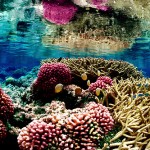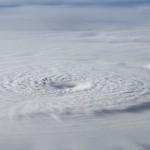Climate Change – Back at Business
This year’s edition of the World Economic Forum (WEF) is up and running at the Swiss mountain resort Davos. It’s the place to be, if you have anything to do with finance and business today. Everyone has descended on Davos, from high level media people to the top notch of the business elite. And there’s no shortage of topics on the agenda this year – the lack of global growth, the euro crisis, of course, and what’s happening in the Middle East. Nothing new here.
But surprisingly there IS something new and unexpected on the delegates’ plates, and it’s called climate change. It’s about time, isn’t it? As if to make a point, a collection of reports that call for prompt and substantial action on climate change, development and sustainability is quite impressive, writes the executive director of the Stockholm Environment Institute, Johann L. Kuylenstierna at RTCC, the official observer to the United Nations climate change negotiations.
There certainly have been a lot of eye-opening climate events over the last year that have grabbed the headlines and left plenty of people baffled. Like the highly debated “pause” in the rise of global temperatures, the inconceivable return of Arctic sea ice or temperatures in Australia that were so high that the Bureau of Meteorologists had to add an extra color to its heat scale.
Two days ago, UN Secretary General Ban Ki-moon called climate change a top priority issue alongside with Syria. That may help the 2,500 people in Davos focus on the climate.
There are quite a few papers and reports that take a look at climate change and it’s implications. The Green Growth Action Alliance led by former Mexican President Felipe Calderón quotes figures that are a stiff wake-up call: some $14 trillion will be needed, say researchers, to be spent on low-carbon industry and infrastructure until 2030. That translates to an investment of $700 billion a year! Calderón’s message is clear: there is no time to waste.
And there’s more: The Global Risks Report 2013 says that stresses on economic and environmental systems are on a “collision course” that could pose “unprecedented challenges” to global and national resilience. Others build cases for addressing climate issues in supply chains and as a strategic response to consumer demands.
None of this is exactly new. But the sheer number of notes or speeches lately could give the climate some momentum in Davos and beyond. Even the fact that US president Barack Obama declared it necessary for the United States to respond to climate change may have been an important sign in itself.
Soot as second worst greenhouse gas
Whenever your candle’s wick is too long, the lit candle produces something called soot. Soot consists of 80 to 95 percent carbon particles, which is why it’s also known as “black carbon”. Researchers have found that black carbon aerosols are actually twice as harmful to the climate as previously thought; in fact, soot is now as the second worst greenhouse gas after CO2.
But of course, it’s not the few candles in your home that are sparking global warming. Scientists trace the damaging effects mainly back to burnt wood and coal in industry and private households. Apart from savanna and bush fires, traditional, simple fires for cooking are the main source of black carbon emissions, researchers say. Another major source are diesel engines that don’t have particle filters.
Black carbon can scatter in the air and land on earth’s surface. It absorbs or disperses sunlight and thereby influences cloud formation and accelerates the melting of snow and ice.
In contrast to CO2, it’s more difficult to evaluate the consequences of black carbon emission because its effect varies depending on air circulation and humidity.
Despite that uncertainty, scientists are confident that climate change could be slowed down by reducing black carbon. They believe it would be possible to reduce global warming by half a degree.
But it’s not only the climate that would gain from slashing black carbon emissions. People’s health would also benefit – diesel smoke, for example, has been linked to lung cancer.
Yet cutting back on black carbon is easier said than done. Most emissions are generated in less developed regions, where the technology needed to avoid or reduce emissions are simply not yet available on a large scale.
Climate wars
It’s getting pretty lonely here. Once a fertile soil this place was home to a colorful lot of different walks of life: neighbors – cooperating, sometimes bickering but never questioning the other’s right to exist. But this place has become increasingly barren, lifeless in an age of global warming: This desert, of course, is the political middle ground in the US climate debate.
Ok, we are not quite there yet. But the signs are alarming. The climate debate, especially in the US, is becoming an increasingly shrill shouting match between extremes so far apart that a normal conversation between neighbors is impossible, with some media outlets taking the lead. The fact that more than 90 percent of Fox coverage on climate change is factually wrong or at least misleading, for instance, does not come as a surprise. Over the last year the situation has gotten worse, even personal. And the launching of attacks is by no means confined to the camp of climate change deniers.
“Exxon hates your children” is the title of a TV ad that bluntly takes aim at the fossil fuel industry.
 And while climate scientists warning about global warming have been known for a while to receive hate mail and death threats, the other side responds in kind. The latest example is an Australian professor calling for the death penalty for climate change deniers.
And while climate scientists warning about global warming have been known for a while to receive hate mail and death threats, the other side responds in kind. The latest example is an Australian professor calling for the death penalty for climate change deniers.
The harassment of climate scientists by deniers appears to be of a more organized nature, but who knows when the warriors against climate change will catch up.
Maybe, it’s just the heat – the worsening extremes in the climate debate are in fact accompanied by unprecedented extreme weather. Eventually, nothing is impossible. Pigs can’t fly, they said, and rivers do not run upstream. But even that may be in doubt: Climate Change is set to reverse the Chicago river in the North-East of the US.
Act now – or you’re (perhaps) wasting money
If planet Earth’s fate is not strong enough an argument for fighting climate change, perhaps money is? Researchers now calculated the costs of climate change: They found that costs enormously increase the longer politicians put off taking action. So are our economies prepared to take the hit?
About 200 country leaders agreed at the UN climate conference in Doha last December to (further) lower greenhouse gas emissions from 2020 on. That is how they want to keep global warming in check limiting it to two degrees compared to the preindustrial level. “If you delay action by 10, 20 years you significantly reduce the chances of meeting the 2 degree target”, Keywan Riahi, IIASA energy program leader and study co-author told Reuters news agency.
The scientists developed a freely available software-tool to test under which conditions the two-degree-target is most likely to be obtained. For the first time, they included all important variables in their calculation: the time elapsed until first action takes place, future energy demand, carbon prices, new energy technologies, and uncertainty about how the climate system reacts.
Though all of them are important, the most crucial one is the time it takes until you take action, Riahi says: “With a twenty-year delay, you can throw as much money as you have at the problem, and the best outcome you can get is a fifty-fifty chance of keeping temperature rise below two degrees.”
2012 in review from a climate change perspective
At the end of the year you get flooded with reviews of 2012. We won’t bore you with another one. Well, we can’t do without revisiting last year at all. So here are some interesting bits and pieces of info on what happened in 2012 from a climate change perspective.
Oil and coal are set to be phased out sooner or later, scientists are busy exploring alternatives. One of them comes straight from the gut. No kidding. In January they presented genetically engineered gut bacteria that could convert seaweed into ethanol. If the process is feasible on large scales, this may help solve the fuel-versus-food- dilemma.
Flood protection for coastal areas, habitat to thousands of species: coral reefs maintain several critical roles in the Earth’s ecosystems – some of which are under particular threat due to climate change. But at the same time corals themselves are threatened by global warming, as NASA scientists confirmed in February following one of the most comprehensive studies yet undertaken on the issue. Rising water temperatures and increasing acidification lead corals to dissolve and die – and the loss of their protective role.
But there is also good news: There is a shift in the climate change debate – from “does climate change exists?” we’ve moved on to “what impacts does climate change have?” and in the best case “how can we prevent it?”. March saw the public discuss a question – well in line with this new level of awareness: Has climate change been underestimated so far? Scientists warned, the global mean temperature could rise by 3 degrees Celsius by 2050.
Climate change is not an isolated problem, but associated with other issues – like food security for example. So, in April, experts and locals discussed at the Climate Smart Agriculture in Asia workshop how to secure rice production in a warming world with more intense droughts and rainfalls. Rice is the staple diet for more than half of the world’s population. At present some 870 million people are already suffering from hunger – not to imagine how this situation will worsen if rice production falls short.
In May world leaders met in Bonn for climate conference – but were not able to agree on any effective measures.
At least a little more optimism could be found at the Rio+20 conference in June: Our reporters Kerstin and Philipp were there for you, presenting innovative people, their ideas and opinions. Re-experience their trip here.
To mitigate global warming, researchers also come up with controversial ideas – most of them attempts to fix the climate by resorting to geoengineering. One idea was highly disputed in July: by dumping iron into the ocean, the ocean’s ability to act as a carbon sink should be increased.
Even some climate skeptics were finally convinced of the reality of climate change, when severe droughts and heat waves hit the United States in the summer months around August. Russia also suffered from extreme droughts, but for the US 2012 has been the hottest year ever recorded.
From dry and hot regions to cold ones: in the middle of September the Arctic ice cover reached an all-time low. Ice melting during the summer is not unusual, but the rate of melting and the large area affected astonished researchers.
Watching the densely populated US East coast brace for the impact of super hurricane Sandy in October, many people around the world paused – the effect of climate change appeared so undeniable as hardly ever before: More and more people in the United States – the developed country with the highest CO2 emissions per capita – start believing that climate change is real.
Following the strong winds, in November researchers declared that sealevels are rising quicker than expected: in fact, the oceans are rising 60 percent faster than previously thought.
In December super-thyphoon Bopha hit the Phillipines, being far stronger than the storm that killed more than 1,200 people in the same region a year earlier. Furthermore the next IPCC report – to be published in 2013 or 2014 – was leaked, revealing that CO2 emissions caused by humans are now “virtually certain” to be the reason for global warming. As this is not really new to a lot of people, country leaders discussed at the climate conference in Doha, Qatar how to deal with climate change. Our reporters Kerstin and Klaus went to Doha for you – revealing all the green ideas they encountered there.
What would you say – anything else we should include to complete our 2012’s climate-change-review?

















Feedback